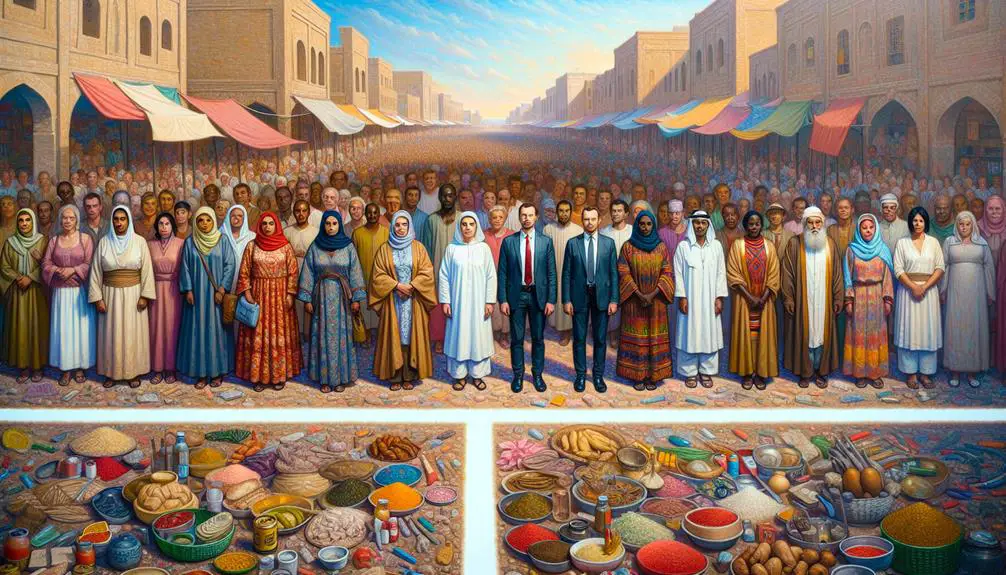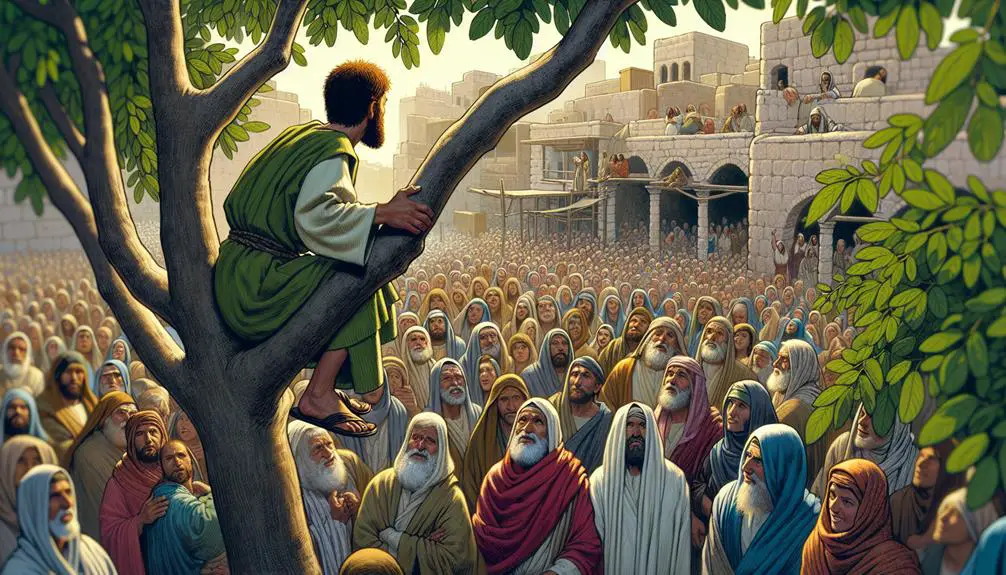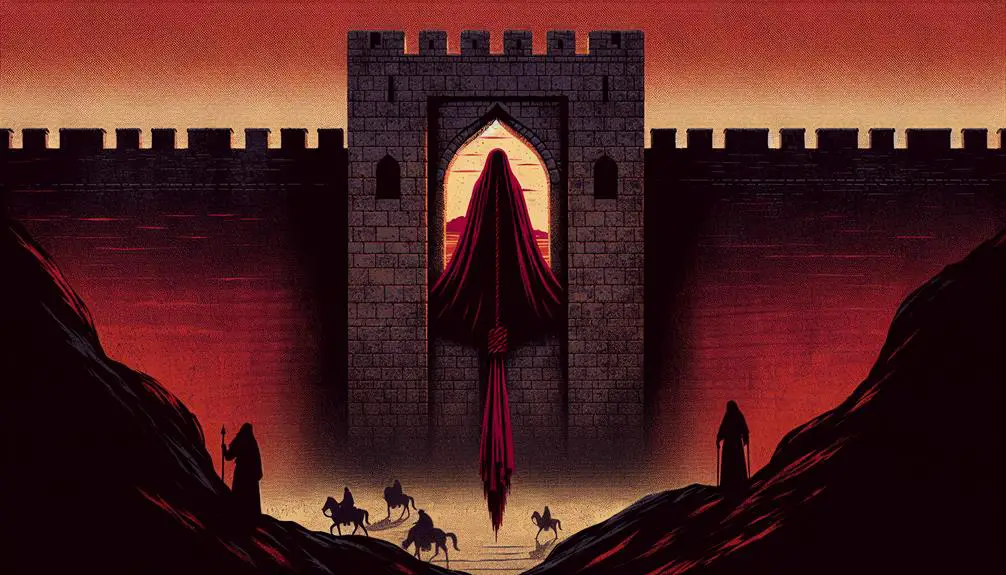Peer into the lives of biblical outcasts and uncover hidden lessons that challenge and inspire—discover their stories.

Outcasts in the Bible
In the vast expanse of biblical narratives, you'll find that outcasts weren't just sprinkled throughout; they were as abundant as stars in the night sky. From the sorrow-laden journey of Job to the transformative encounter of the Samaritan woman at the well, these stories aren't just ancient history; they're profound lessons wrapped in the guise of narratives.
As you explore the depths of Mary Magdalene's redemption or the unexpected heroism of the Good Samaritan, you'll uncover insights that challenge modern perceptions of outcasts. So, why not journey through these tales? You might discover that the line between outcast and hero is thinner than you've ever imagined.
Key Takeaways
- The Bible frequently showcases outcasts undergoing redemption and societal reintegration.
- Biblical narratives often challenge societal norms and prejudices through acts of compassion and empathy.
- Stories of divine grace and redemption emphasize the overcoming of physical and social stigmas.
- Outcasts play pivotal roles, symbolizing themes of grace, societal inclusion, and the transcending of human judgments.
The Story of Job

The story of Job, a tale of suffering and faith, presents a compelling exploration of the human condition when faced with profound loss and adversity. At its core, this narrative revolves around Job's patience and a divine wager that tests the limits of human endurance and faithfulness. Job, a man of immense prosperity and piety, becomes the subject of a celestial bet between God and Satan. The divine wager posits whether a righteous individual can maintain their integrity and faith in God amidst severe suffering and misfortune, absent of any tangible rewards.
Job's unwavering patience throughout his ordeal becomes a focal point of the narrative. Stripped of his wealth, health, and family, he embodies the quintessence of perseverance and steadfast faith. Despite his friends' accusations of moral failings as the cause of his miseries, Job refuses to renounce his integrity or curse God. His resilience in the face of inexplicable suffering challenges the conventional wisdom of retributive justice, which suggests that good is rewarded and evil is punished.
This narrative invites a scholarly examination of the human capacity for faith and endurance under duress. Job's story transcends a mere account of personal affliction; it probes deeper philosophical questions about the nature of suffering, the righteousness of God, and the virtue of patience. The divine wager, thus, serves as a catalyst for a broader discourse on the complexities of faith, the inscrutability of divine intentions, and the human struggle to find meaning amidst suffering.
Mary Magdalene's Redemption

You'll find that Mary Magdalene's journey from an outcast to a key figure in Christian narratives encompasses her early life, transformative devotion, and crucial role in witnessing the Resurrection.
Her story, marked by redemption, challenges prevailing societal norms and offers insight into the dynamics of grace and forgiveness.
Analyzing her path provides a nuanced understanding of her significance in both theological and historical contexts.
Mary's Early Life
Mary Magdalene's early life, often shrouded in mystery and controversy, plays a pivotal role in her journey towards redemption as depicted in biblical narratives. While specific details about her origins remain sparse, the broader context of her era illuminates the societal and religious frameworks she navigated.
Notably, the concepts of virgin birth and angelic visitation, central to early Christian narratives, underscore the miraculous and divine intervention present in the lives of biblical figures. These elements, though not directly tied to Mary Magdalene's story, establish a cultural backdrop that influences interpretations of her character and redemption arc.
Analyzing her early life through this lens offers insights into the transformative power of faith and the complex dynamics of societal outcasts seeking acceptance and redemption within their communities.
Transformation and Devotion
Embarking on a path of profound transformation, Mary Magdalene's journey from outcast to devoted follower exemplifies her redemption within the biblical narrative. This shift wasn't merely a change in her societal status but a testament to the power of personal transformation and divine devotion.
Her story isn't just one of redemption but also a demonstration of unwavering faith and the transformative power of spiritual awakening. Mary's dedication to her new path showcases the profound impact that divine devotion can have on an individual's life.
Her transformation is depicted not as an immediate change but as a gradual process, emphasizing the depth of her commitment and the sincerity of her devotion. Through Mary Magdalene, the narrative illustrates the potential for redemption and the importance of personal transformation in achieving true devotion.
Witnessing the Resurrection
In the narrative of Mary Magdalene's redemption, her witnessing of the Resurrection stands as a pivotal moment, underscoring her profound transformation and unyielding devotion.
The discovery of the empty tomb marks the beginning of this transformative journey. This event isn't just a moment of surprise or confusion; it's a critical juncture in the Appearances narratives, where Mary's role transitions from a follower to a witness of Christ's victory over death.
Analyzing these texts, you'll find that her encounter with the risen Christ outside the empty tomb isn't merely an act of witnessing but a commissioning.
Mary Magdalene's role in these narratives challenges societal norms of the time, elevating her from an outcast to a pivotal figure in the early Christian community.
Zacchaeus the Tax Collector

Zacchaeus, a tax collector in Jericho, represents a profound example of societal redemption and personal transformation within biblical narratives. His story is particularly compelling when examining the complexities of tax collection ethics and the resultant social ostracization. In Zacchaeus' time, tax collectors were often despised for their association with the Roman occupiers and presumed dishonesty, making Zacchaeus an outcast in his own community.
The table below captures the essence of Zacchaeus' journey from outcast to redeemed figure, illustrating the emotional depth of his transformation:
Emotional State |
Description |
|---|---|
Desolation |
Initially, Zacchaeus experiences profound loneliness, cast aside by society due to his profession and perceived ethical breaches. |
Curiosity |
His curiosity about Jesus signifies the beginning of his internal transformation, driven by a deep-seated desire for acceptance and understanding. |
Redemption |
Upon meeting Jesus and committing to restitution, Zacchaeus finds redemption, not just spiritually but also within his community. |
This narrative arc highlights the potential for change, emphasizing that societal outcasts can find redemption through personal transformation and ethical actions. Zacchaeus' story serves as a powerful reminder of the capacity for forgiveness and the importance of individual agency in overcoming social ostracization. Through this lens, the biblical account of Zacchaeus challenges readers to reconsider their perspectives on ethics, redemption, and the inherent value of every individual, regardless of their societal status or past actions.
The Good Samaritan

You now encounter the narrative of the Good Samaritan, an emblematic example of unexpected compassion and the overcoming of social barriers.
This parable highlights the Samaritan's act of kindness towards a stranger, challenging societal norms and prejudices of the time.
Samaritan's Unexpected Compassion
Many overlook the profound lesson of compassion and societal critique embedded in the parable of the Good Samaritan, a narrative that challenges prevailing prejudices and invites a reevaluation of what it means to be a neighbor. Through this parable, you're confronted with cultural prejudices that deeply influenced the social dynamics of the time.
Samaritans, often viewed with disdain by their Jewish counterparts, are placed at the forefront of a discussion on neighborly duties. The Samaritan's actions dissect the conventional understanding of community and obligation, illustrating that true compassion knows no boundaries.
This narrative meticulously unravels the fabric of societal expectations, urging a reflection on the essence of kindness and the universal application of neighborly duties, devoid of cultural biases.
Social Barriers Overcome
Building on the Samaritan's act of kindness, it's imperative to explore how this parable significantly dismantles social barriers that were deeply entrenched in the society of the time. Through the lens of this narrative, you witness a radical challenge to the prevailing norms of segregation and alienation.
The Samaritan, traditionally viewed as a social outcast, emerges not only as a protagonist but as a beacon of universal compassion, transcending cultural and ethnic divisions. This act of mercy serves as a potent counter-narrative to the deeply rooted prejudices of the day, illustrating the transformative power of empathy in overcoming prejudice.
The parable, therefore, doesn't merely recount an act of kindness; it articulates a profound critique of societal divisions, advocating for a community where compassion overrides the constructs that designate individuals as social outcasts.
The Cleansing of a Leper

In the biblical narrative, the cleansing of a leper represents a profound act of healing and social restoration, symbolizing not only physical but also spiritual renewal. This event is deeply rooted in the context of leprosy stigma and the quest for ritual purity, which are central to understanding the societal implications of this act.
Leprosy, in ancient times, wasn't just a physical ailment but carried heavy social and religious connotations. It rendered individuals ritually impure, isolating them from the community and the religious life of the people. The cleansing of a leper, therefore, wasn't merely a healing of the body but a restoration of the individual to their community and religious practices.
Here are three key aspects to consider:
- Leprosy Stigma: The stigma attached to leprosy was profound. It signified not just illness but a kind of living death, a social and spiritual separation from the community. Lepers were outcasts, living on the margins of society.
- Ritual Purity: Ritual purity was essential for participation in community and religious life. The cleansing of a leper, therefore, had profound implications, signifying a return to a state of purity that allowed reintegration into society and religious observance.
- Social Restoration: The act of cleansing was a powerful symbol of social restoration. It wasn't just about the individual's physical healing but about their acceptance back into the fold, restoring their place and dignity within the community.
The cleansing of a leper in the biblical texts, thus, transcends the physical act of healing, touching on themes of purity, stigma, and social integration.
Rahab the Harlot

Rahab the Harlot's story, found in the Book of Joshua, offers a compelling exploration of grace, redemption, and the unexpected roles individuals can play in divine plans. Her narrative is intricately tied to Jericho's fall, a pivotal event in the Israelites' conquest of the Promised Land. Rahab, despite her marginalized status, plays a crucial role by providing shelter to the spies sent by Joshua. This act of faith and allegiance drastically alters her fate and underscores the theme of salvation for those who are deemed unworthy by societal standards.
Aspect |
Significance |
Outcome |
|---|---|---|
Rahab's Profession |
Symbolizes societal marginalization |
Becomes a conduit for divine action |
Sheltering Spies |
Act of faith and treason against Jericho |
Ensures her family's survival |
Red Cord |
Symbol of protection and agreement |
Marks her house for Hebrew spies' recognition |
Jericho's Fall |
Represents divine intervention and judgment |
Rahab and her family are spared |
Genealogy Inclusion |
Integrated into the lineage of David and Jesus |
Highlights redemption and grace |
Rahab's story challenges the reader to reconsider the boundaries of God's grace and the potential for redemption. Her inclusion in the genealogy of Jesus in the New Testament further emphasizes the theme that divine grace transcends human judgments and societal labels. Rahab's narrative, therefore, is not just a tale of Jericho's fall or a simple case of spies' shelter but a profound lesson on the expansiveness of redemption and the intricate ways in which the marginalized can play significant roles in the unfolding of divine plans.
The Woman at the Well

Just as Rahab's story illuminates the theme of redemption for the marginalized, the narrative of the Woman at the Well further explores the depth of divine grace extended to those on society's fringes. This Samaritan woman's encounter with Jesus at Jacob's well serves as a poignant example of how cultural norms and social isolation can conspire to alienate individuals.
- Social Isolation: The woman's midday visit to the well, a time when few ventured out, underscores her status as an outcast. This timing wasn't incidental; it was a deliberate choice to avoid the social scrutiny and ostracization she faced due to her life choices and marital status. Her social isolation is palpable, illustrating how societal judgment can push individuals to the periphery.
- Cultural Norms: The interaction breaks multiple cultural norms of the time. First, Jesus, a Jew, initiates a conversation with a Samaritan, a group despised by Jews. Second, He speaks to a woman publicly, which was considered inappropriate. This deliberate breach of norms by Jesus highlights the inclusive nature of divine grace, which transcends societal barriers.
- Divine Grace: The conversation reveals a profound theological exchange, where Jesus offers her 'living water,' symbolizing eternal life and salvation. This offer, extended to someone deemed unworthy by societal standards, underscores the unconditional nature of divine grace.
Through this narrative, you observe the transformative power of acceptance and the dismantling of barriers erected by cultural norms and social isolation. The Woman at the Well's story is a testament to the potential for renewal and inclusion, regardless of one's past or societal status.
Frequently Asked Questions
How Did the Concept of Outcasts in Biblical Times Differ From Our Understanding of Social Outcasts Today?
In ancient times, outcasts were determined by strict cultural norms and social hierarchy, unlike today's broader, more inclusive understanding.
You'll find that back then, societal rules rigidly dictated who fit in or who didn't, often based on factors like purity laws, lineage, and occupation.
Nowadays, while social exclusion still exists, it's more fluid and subjective, reflecting personal biases rather than a universally accepted set of criteria.
This shift reflects evolving societal values and norms.
Are There Any Examples of Outcasts in the Bible Who Were Not Directly Redeemed or Whose Stories Did Not End in Redemption?
You're asking if there are instances in the Bible where outcasts weren't redeemed. Indeed, there are.
Take Gehazi's downfall, for instance; struck with leprosy for his greed, his story lacks a redemptive turnaround. Similarly, Achan's fate, who was stoned to death for his disobedience, shows no redemption.
These examples highlight how not all biblical narratives of outcasts conclude with a positive transformation or redemption, contrasting with many stories where redemption is central.
How Did the Treatment of Outcasts in the Bible Influence Early Christian Communities' Approaches to Marginalization and Social Justice?
When examining how early Christian communities approached marginalization and social justice, it's clear they were deeply influenced by themes of Divine Mercy and Social Inclusion.
You'll find that their actions towards the marginalized weren't just acts of charity but were deeply rooted in a theological understanding that saw every person as worthy of respect and love.
This approach transformed how they interacted with those on the fringes of society, setting a precedent for future generations.
In What Ways Do Modern Religious Scholars Interpret the Roles and Stories of Biblical Outcasts Differently Than in Past Centuries?
You're navigating a maze of interpretations, where modern scholars use fresh lenses to view ancient texts. They pivot from past views, employing historical context and innovative interpretive methods to understand biblical outcasts.
Like decoding a centuries-old puzzle, they're revealing new insights into these stories. This shift isn't just academic; it's reshaping our comprehension of social justice and community roles, echoing the evolving perspectives on marginalization within religious studies today.
Can the Concept of Being an Outcast as Depicted in the Bible Be Related to Any Contemporary Issues Facing Society Today?
Absolutely, the notion of being an outcast can mirror contemporary societal issues such as digital isolation and economic disparity.
You'll find that these modern challenges echo the isolation and marginalization depicted in ancient texts. By analyzing this, you're engaging in a critical examination of how exclusionary practices have evolved, yet remain impactful.
This approach not only broadens your understanding but also highlights the persistent nature of social inequities and their effects on individuals.
Conclusion
In analyzing these biblical narratives, it's evident that they collectively weave a tapestry of redemption and acceptance, highlighting the inherent value of those society deems outcasts. Like stars scattered across a dark sky, each story shines light on the transformative power of compassion, challenging us to redefine our perceptions of worthiness.
This scholarly exploration underscores a profound biblical principle: true righteousness isn't in societal standing, but in the embrace of the marginalized, illuminating the path to a more inclusive faith.



Sign up